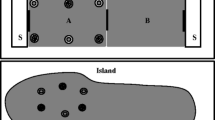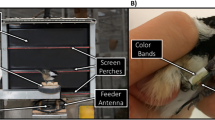Abstract
Learning and memory studies have been performed for more than two decades using the crab Chasmagnathus in our laboratory. Here, our research was aimed at disclosing some instances of learning in field conditions. Three experiments were performed non-simultaneously, all with a 22.5-min pre-training preceding the first visual-danger-stimulus, an opaque rectangle passing overhead. In Experiment 1, crabs received a single stimulus followed by 22.5-min testing without stimulation, where the re-emerging latency was considered the basic latency response. In Experiment 2, training consisted of 15 stimulus 3-min apart, followed by 22.5-min testing without stimulation. Throughout training crabs were underground but re-emerged at testing with latencies longer than the basic latency response. Both at pre-training and testing the usual strategy of exploring was the short-near excursions. In Experiment 3, training included three stimulus 22.5-min apart, followed by 22.5-min testing. Crabs left their burrows before the end of each inter-trial, showing a mean latency like the basic latency response, but a sensitization to the stimulus and a preponderance of the fast-far excursions over the usual slow-near. In brief: through 15-3 training, crabs learn that the stimulus is iteratively presented; through 3-22.5 training, crabs acquire sensitization to the stimulus and a different strategy of exploration.








Similar content being viewed by others
Abbreviations
- VDS:
-
Visual danger stimulus
- CSM:
-
Context signal memory
- REL:
-
Re-emerging latency
- UPPre-tr :
-
Unprovoked burrow use during pre-training
- Pd-VDS :
-
Provoked burrow use caused by direct-VDS
- Pi-VDS :
-
Provoked burrow use caused by indirect-VDS
- Ptotal :
-
Total provoked burrow use
- ITI:
-
Inter-trial interval
References
Aggio J, Rakitin A, Maldonado H (1996) Serotonin-induced short- and long-term sensitization in the crab Chasmagnathus. Pharmacol Biochem Behav 53:441–448
Beron de Astrada M, Maldonado H (1999) Two related forms of long-term habituation in the crab Chasmagnathus are differentially affected by scopolamine. Pharmacol Biochem Behav 63:109–118
Bolles RC (1970) Species-specific defense reactions and avoidance learning. Psychol Rev 77:32–48
Carbó Tano M, Molina VA, Maldonado H, Pedreira ME (2009) Memory consolidation and reconsolidation in an invertebrate model: the role of the GABAergic system. Neuroscience 158:387–401
Daniel WW (1978) Applied nonparametric statistics. Houghton Mifflin Co., Boston
Delorenzi A, Pedreira ME, Romano A, Garcia SI, Pirola CJ, Nahmod VE, Maldonado H (1996) Angiotensin II enhances long-term memory in the crab Chasmagnathus. Brain Res Bull 41:211–220
Delorenzi A, Dimant B, Frenkel L, Nahmod VE, Nassel DR, Maldonado H (2000) High environmental salinity induces memory enhancement and increases levels of brain angiotensin-like peptides in the crab Chasmagnathus granulatus. J Exp Biol 203:3369–3379
Fathala MV, Kunert C, Maldonado H (2009) A field model of learning: 2. Long-term memory in the crab Chasmagnathus granulatus. J Comp Physiol A. doi:10.1007/s00359-009-0495-7
Feld M, Dimant B, Delorenzi A, Coso O, Romano A (2005) Phosphorylation of extra-nuclear ERK/MAPK is required for long-term memory consolidation in the crab Chasmagnathus. Behav Brain Res 158:251–261
Forcato C, Burgos VL, Argibay PF, Molina VA, Pedreira ME, Maldonado H (2007) Reconsolidation of declarative memory in humans. Learn Mem 14:295–303
Forcato C, Argibay PF, Pedreira ME, Maldonado H (2009) Human reconsolidation does not always occur when a memory is retrieved: the relevance of the reminder structure. Neurobiol Learn Mem 91:50–57
Frenkel L, Maldonado H, Delorenzi A (2005) Memory strengthening by a real-life episode during reconsolidation: an outcome of water deprivation via brain angiotensin II. Eur J Neurosci 22:1757–1766
Freudenthal R, Romano A (2000) Participation of Rel/NF-kappaB transcription factors in long-term memory in the crab Chasmagnathus. Brain Res 855:274–281
Hemmi J (2005a) Predator avoidance in fiddler crabs: 1. Escape decisions in relation to the risk of predation. Anim Behav 69:603–614
Hemmi J (2005b) Predator avoidance in fiddler crabs: 2. The visual cues. Anim Behav 69:615–625
Hemmi JM, Zeil J (2003a) Burrow surveillance in fiddler crabs. I. Description of behaviour. J Exp Biol 206:3935–3950
Hemmi JM, Zeil J (2003b) Burrow surveillance in fiddler crabs. II. The sensory cues. J Exp Biol 206:3951–3961
Iribarne O, Martinez M (1999) Predation on the southwestern atlantic fiddler crab (Uca uruguayensis) by migratory shorebirds (Pluvialis dominica, P. squatarola, Arenaria interpres and Numenius phaeopus). Estuaries 22:47–54
Jennions MD, Backwell PRY, Murai M, Christy JH (2003) Hiding behaviour in fiddler crabs: how long should prey hide in response to a potential predator? Anim Behav 66:251–257
Layne JE, Barnes WJ, Duncan LM (2003a) Mechanisms of homing in the fiddler crab Uca rapax. 1. Spatial and temporal characteristics of a system of small-scale navigation. J Exp Biol 206:4413–4423
Layne JE, Barnes WJ, Duncan LM (2003b) Mechanisms of homing in the fiddler crab Uca rapax. 2. Information sources and frame of reference for a path integration system. J Exp Biol 206:4425–4442
Locatelli F, Maldonado H, Romano A (2002) Two critical periods for cAMP-dependent protein kinase activity during long-term memory consolidation in the crab Chasmagnathus. Neurobiol Learn Mem 77:234–249
Maldonado H (2002) Crustacean as model to investigate memory illustrated by extensive behavioral and physiological studies in Chasmagnathus. In: Wiese K (ed) The crustacean nervous system. Springer, Berlin, pp 314–327
Menone ML, Miglioranza KS, Iribarne O, Aizpun de Moreno JE, Moreno VJ (2004) The role of burrowing beds and burrows of the SW Atlantic intertidal crab Chasmagnathus granulata in trapping organochlorine pesticides. Mar Pollut Bull 48:240–247
Pedreira ME, Dimant B, Tomsic D, Quesada-Allue LA, Maldonado H (1995) Cycloheximide inhibits context memory and long-term habituation in the crab Chasmagnathus. Pharmacol Biochem Behav 52:385–395
Pedreira ME, Dimant B, Maldonado H (1996) Inhibitors of protein and RNA synthesis block context memory and long-term habituation in the crab Chasmagnathus. Pharmacol Biochem Behav 54:611–617
Pratt AE, McLain DK, Berry AS (2005) Variation in the boldness of courting sand fiddler crabs (Uca pugilator). Ethology 111:63–76
Rescorla RA (1988) Pavlovian conditioning. It’s not what you think it is. Am Psychol 43:151–160
Romano A, Locatelli F, Freudenthal R, Merlo E, Feld M, Ariel P, Lemos D, Federman N, Fustinana MS (2006) Lessons from a crab: molecular mechanisms in different memory phases of Chasmagnathus. Biol Bull 210:280–288
Smith WK, Miller PC (1973) The thermal ecology of two south Florida fiddler crabs: Uca rapax Smith and U. pugilator Bosc. Physiol Zool 46:186–207
Sokal RR, Rohlf FJ (1995) Biometry. W. H. Freeman, New York
Sztarker J, Tomsic D (2008) Neuronal correlates of the visually elicited escape response of the crab Chasmagnathus upon seasonal variations, stimuli changes and perceptual alterations. J Comp Physiol A 194:587–596
Tomsic D, Massoni V, Maldonado H (1993) Habituation to danger stimulus in two semiterrestrial crabs: ontogenic, ecological and opioids modulation correlates. J Comp Physiol A 173:621–633
Tomsic D, Beron de Astrada M, Sztarker J (2003) Identification of individual neurons reflecting short- and long-term visual memory in an arthropod. J Neurosci 23:8539–8546
Troncoso J, Maldonado H (2002) Two related forms of memory in the crab Chasmagnathus are differentially affected by NMDA receptor antagonists. Pharmacol Biochem Behav 72:251–265
Zar JH (1999) Biostatistical analysis. Prentice–Hall, Upper Saddle River
Zeil J (1998) Homing in fiddler crabs (Uca lacteal annulipes and Uca vomeris: Ocypodidae). J Comp Physiol A 183:367–377
Zeil J, Hemmi JM (2006) The visual ecology of fiddler crabs. J Comp Physiol A 192:1–25
Acknowledgments
We thank D. Tomsic for helpful comments on the manuscript, M. Carbó for artwork support and G. Piriz and M. Tedesco for technical assistance in the field. This work was supported by FONCYT (Grant PICTR 00349, PICT-2006-02261), UBACYT (Grant X326) and CONICET (PIP 112-200801-02457 and PIP 2004-5466).
Author information
Authors and Affiliations
Corresponding author
Electronic supplementary material
Below is the link to the electronic supplementary material.
359_2009_494_MOESM1_ESM.pdf
Definitions of terms used in the present paper and in the companion one (Fathala et al. 2009)
359_2009_494_MOESM2_ESM.pdf
Unprovoked and provoked retreats and burrow use. An unprovoked retreat comprises a homeward movement and retreat into the burrow and originates an unprovoked burrow use. On the other hand, a provoked retreat is characterized by a home run triggered by the predator-like stimulus and is followed by a provoked burrow use. In both cases the re-emerging latency time (REL) is the time between the entry into the burrow and the next re-emergence
359_2009_494_MOESM3_ESM.pdf
Variables used for estimating stay of the crabs inside their burrows. Two active burrows are considered as examples. Exploratory excursions at surface are shown as white rectangles. Each exploratory excursion begins when the crab emerges from the burrow (↑) and ends when the animal retreats underground (↓). This hiding may be triggered by the VDS activation (provoked burrow use) or may occur without any experimental stimulation (unprovoked burrow use). The re-emerging latency time (REL) between the VDS activation (bold arrow) and the beginning of the first exploratory excursion at testing is termed Provoked REL (Ptotal). The Ptotal may be either Pd-VDS (gross line) or Pi-VDS (dotted line), if the REL registered occur after a provoked or an unprovoked burrow use, respectively. The UPPre-tr refers to the mean time between any two successive exploratory excursions during the entire Pre-training period (dashed lines)
Rights and permissions
About this article
Cite this article
Fathala, M.V., Iribarren, L., Kunert, M.C. et al. A field model of learning: 1. Short-term memory in the crab Chasmagnathus granulatus . J Comp Physiol A 196, 61–75 (2010). https://doi.org/10.1007/s00359-009-0494-8
Received:
Revised:
Accepted:
Published:
Issue Date:
DOI: https://doi.org/10.1007/s00359-009-0494-8




